





















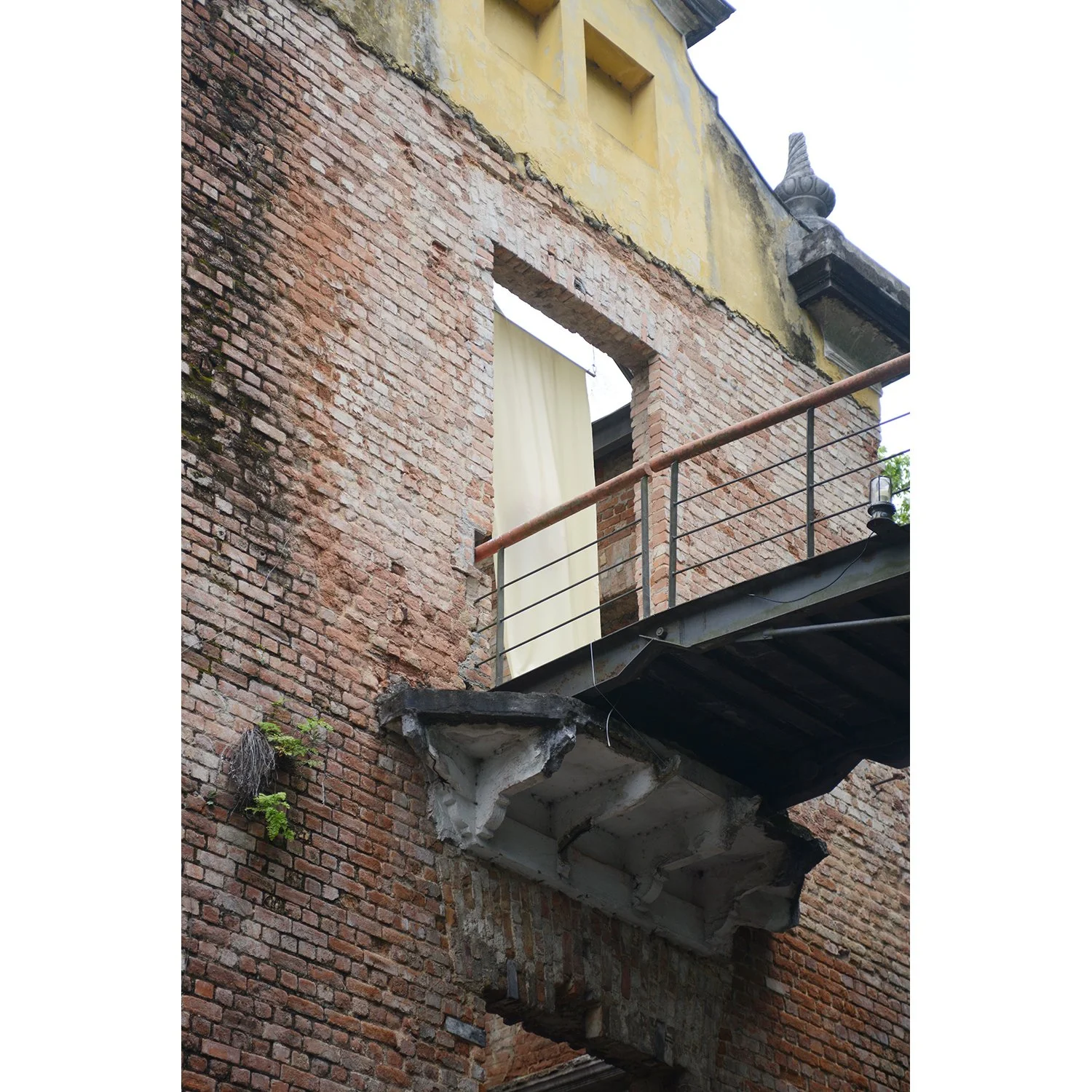













































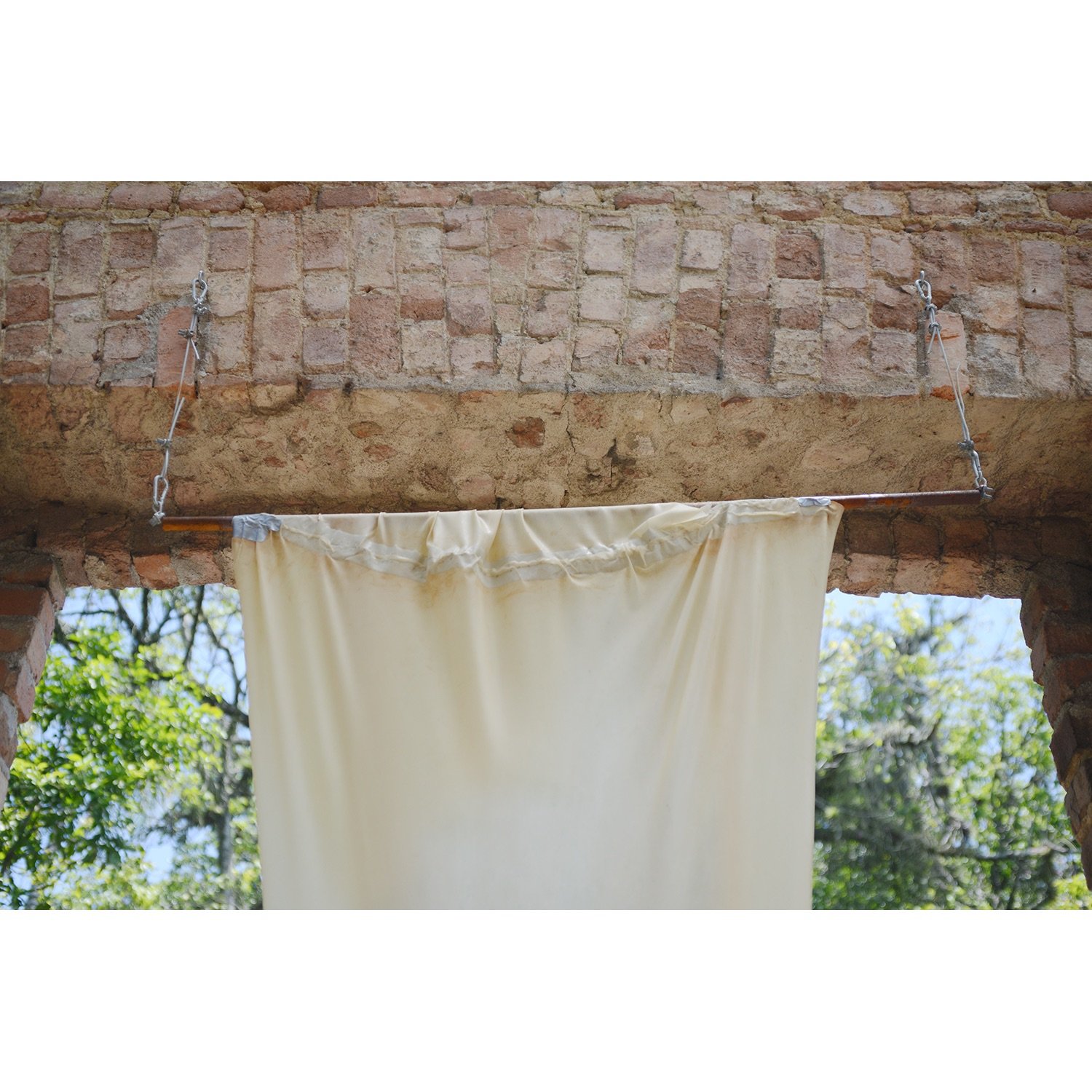
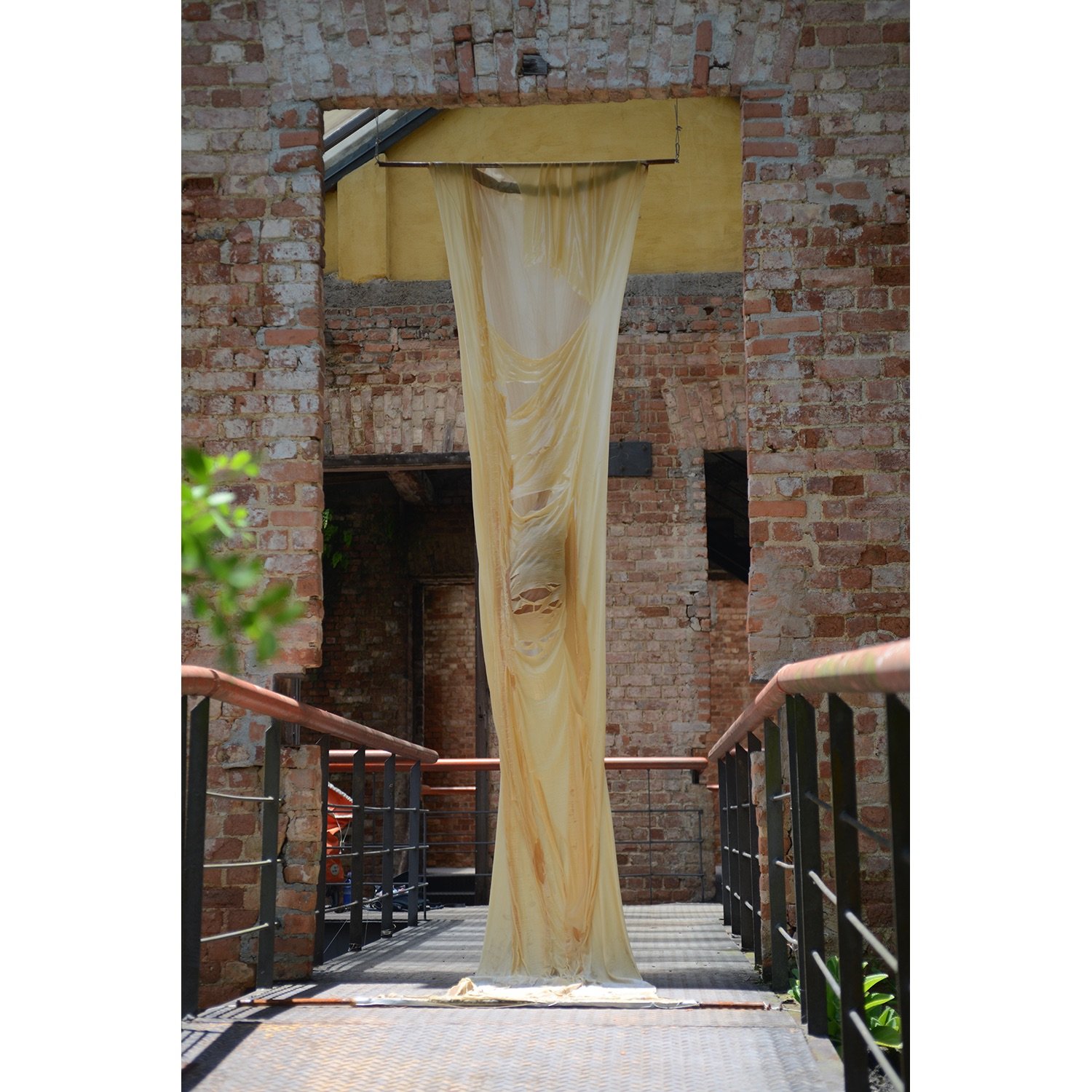
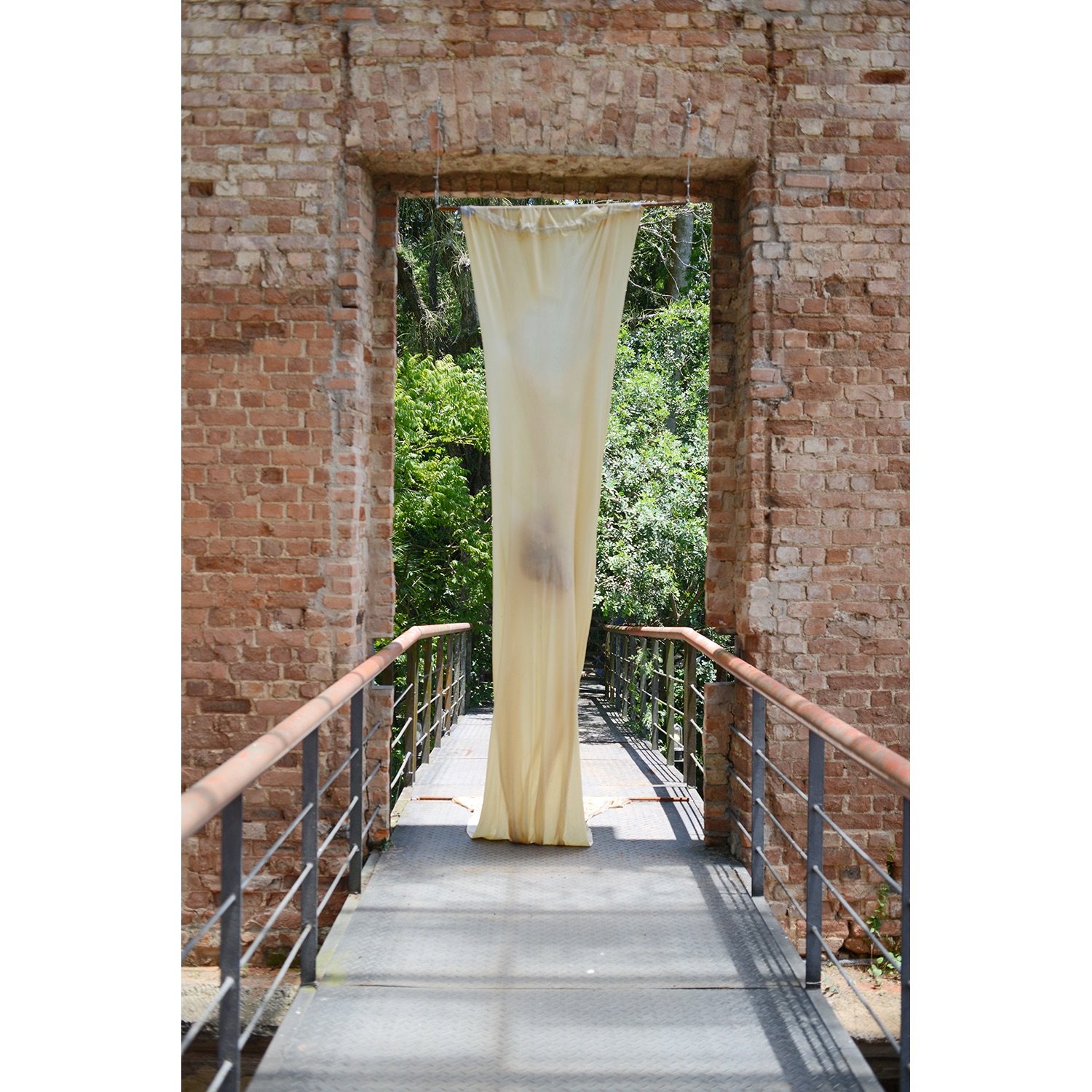

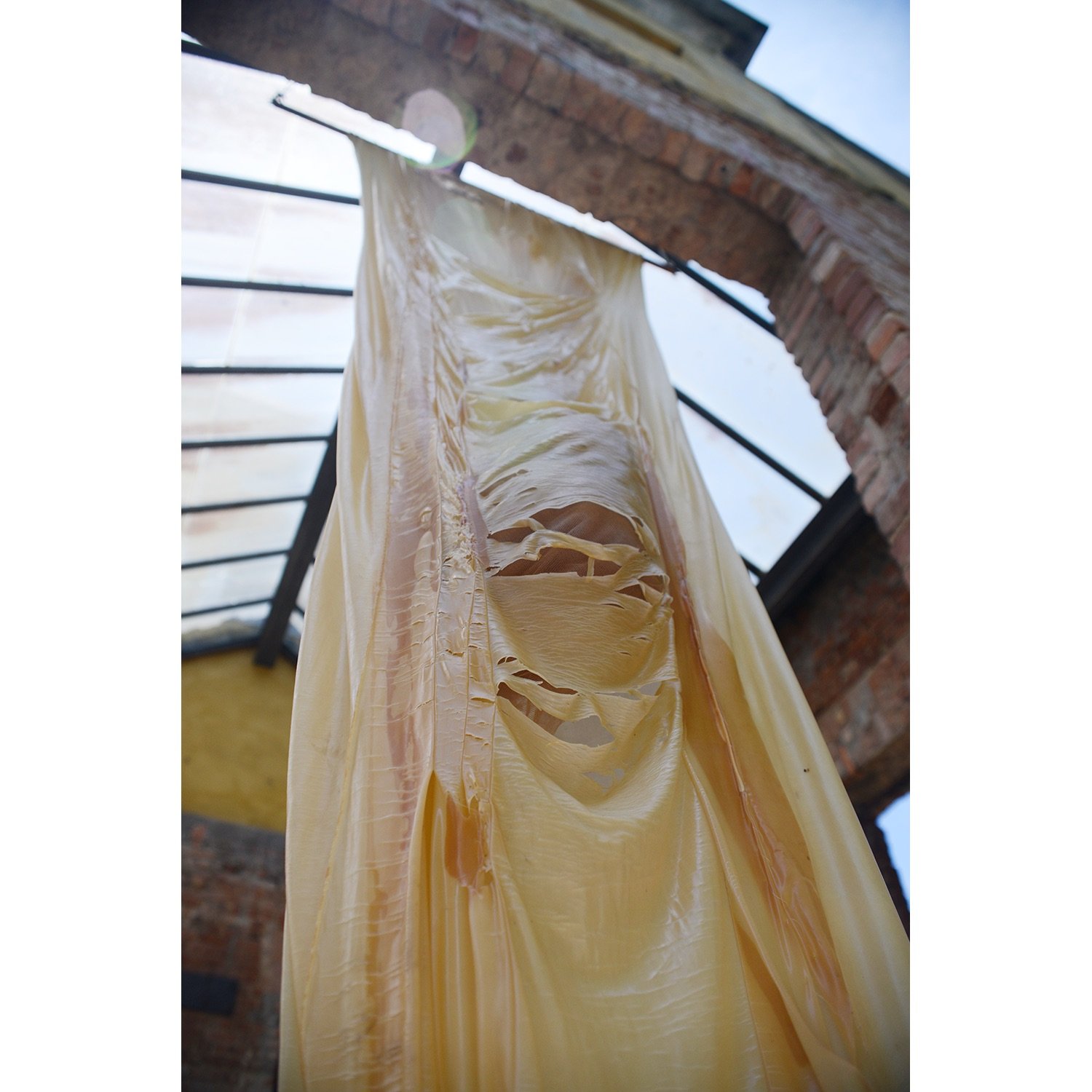
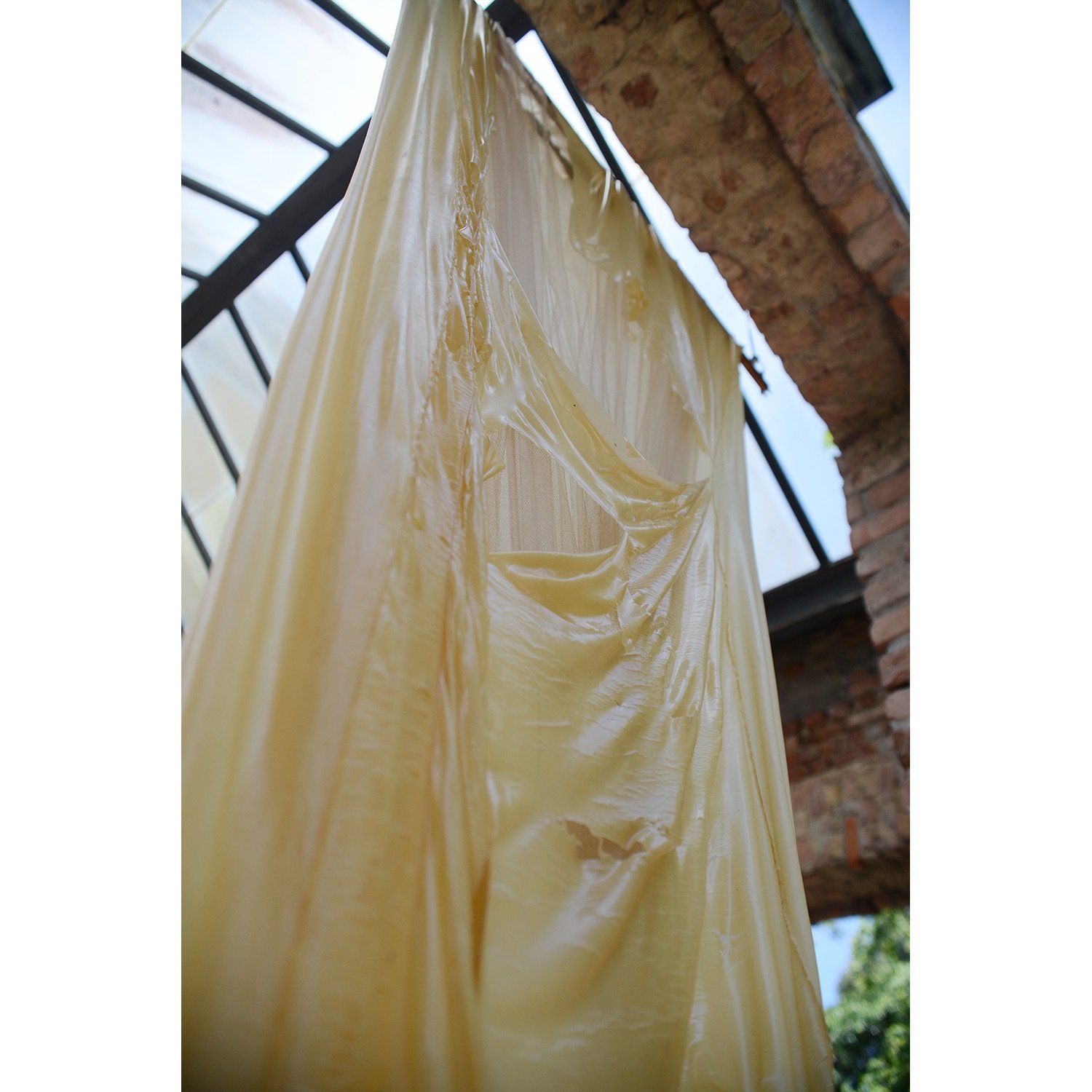
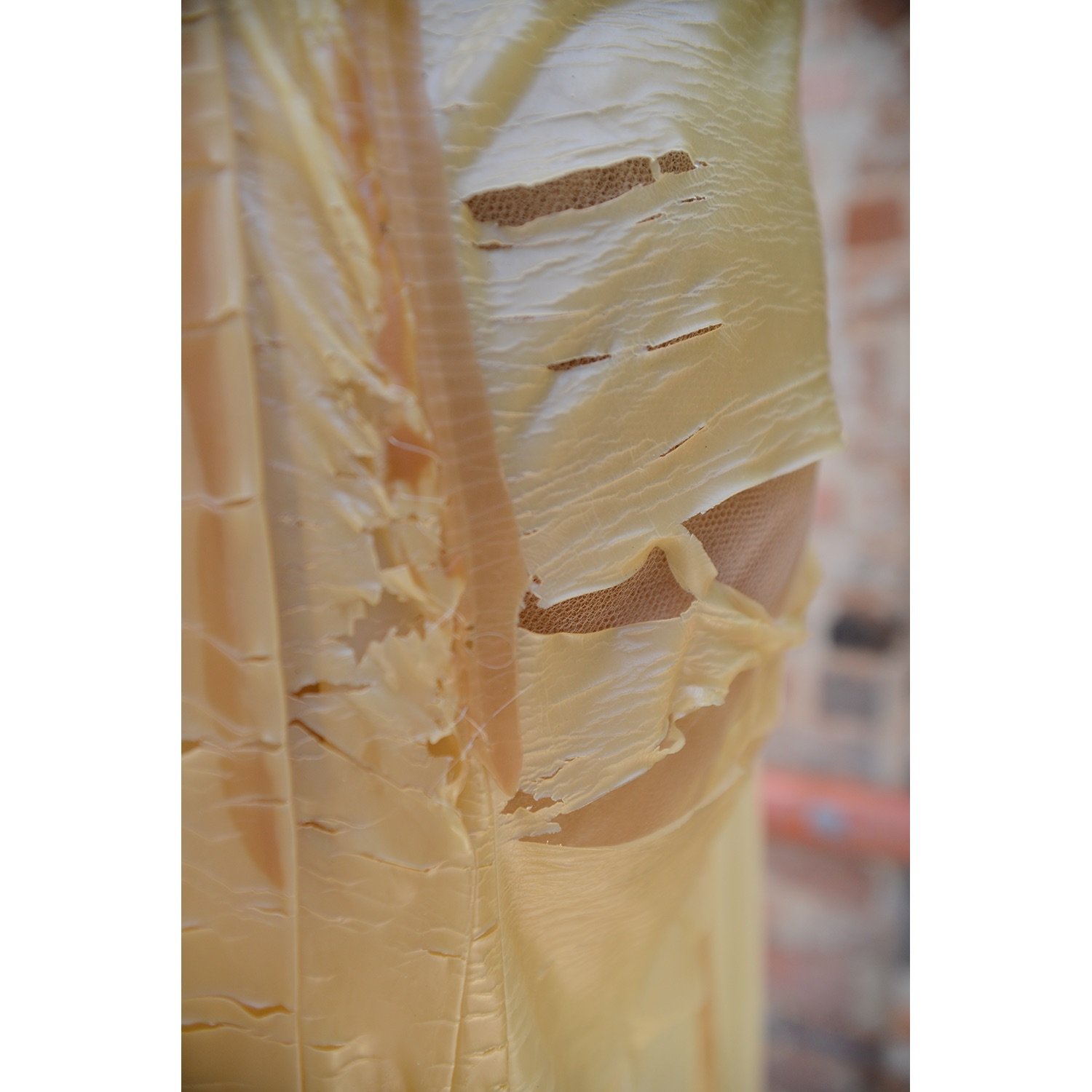
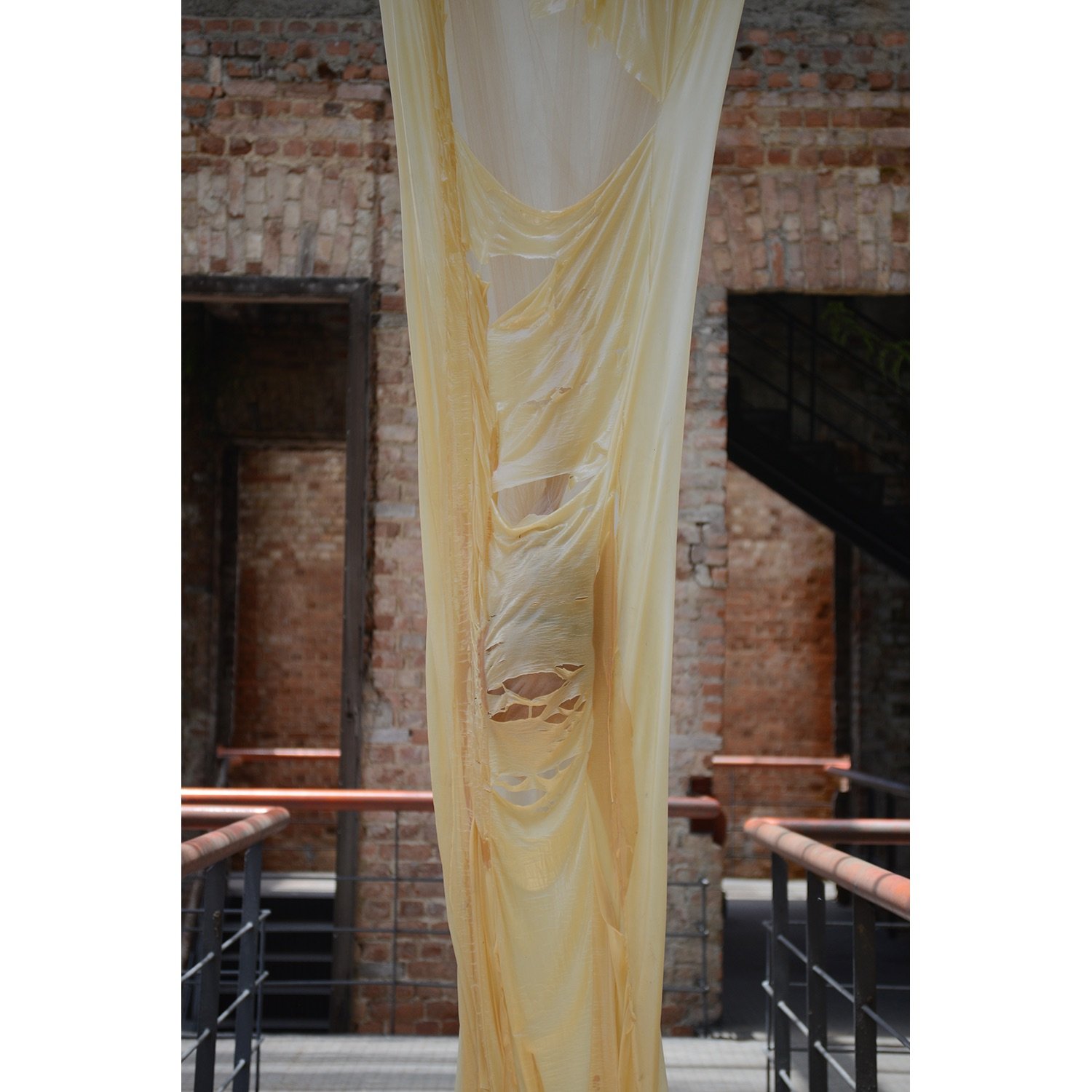
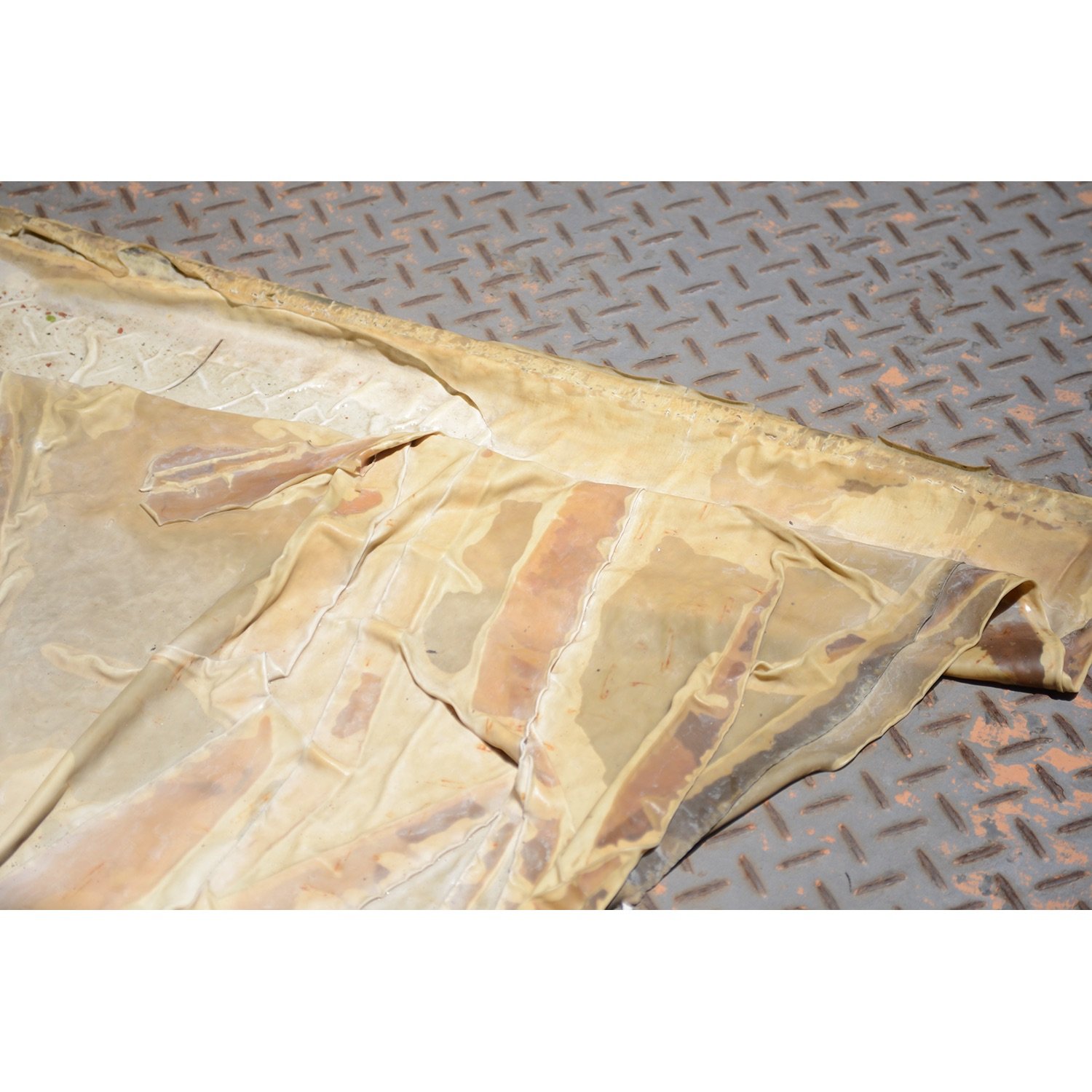
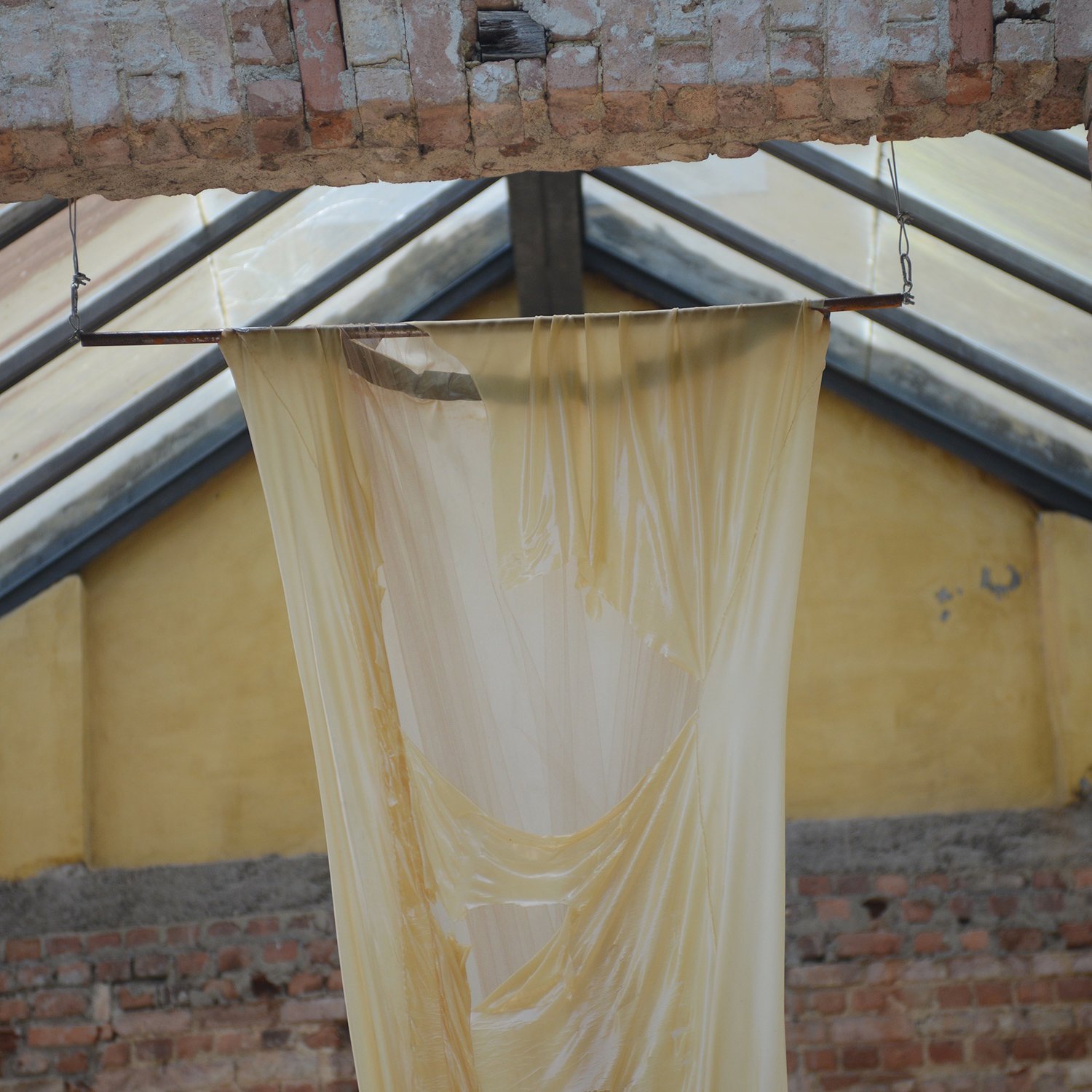












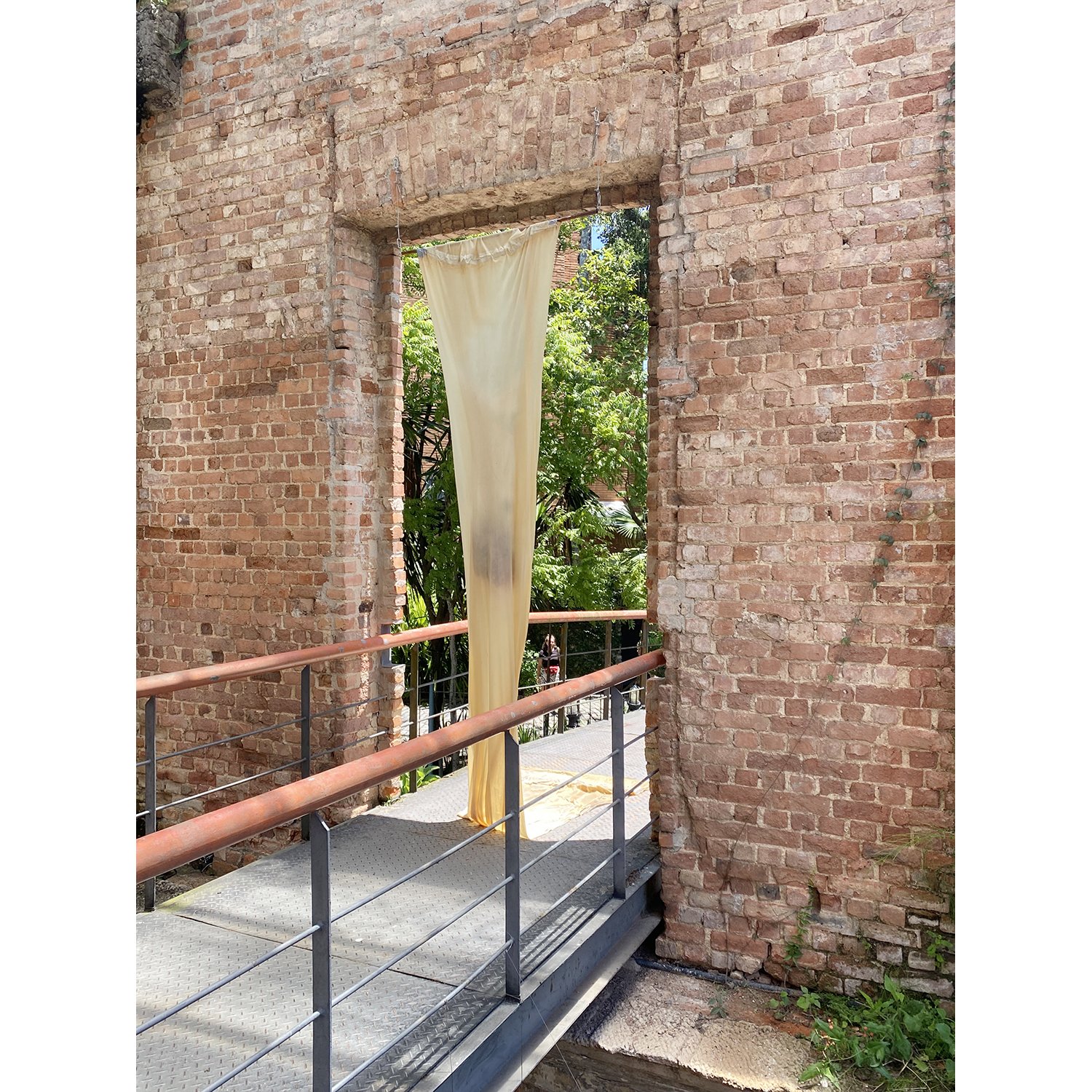
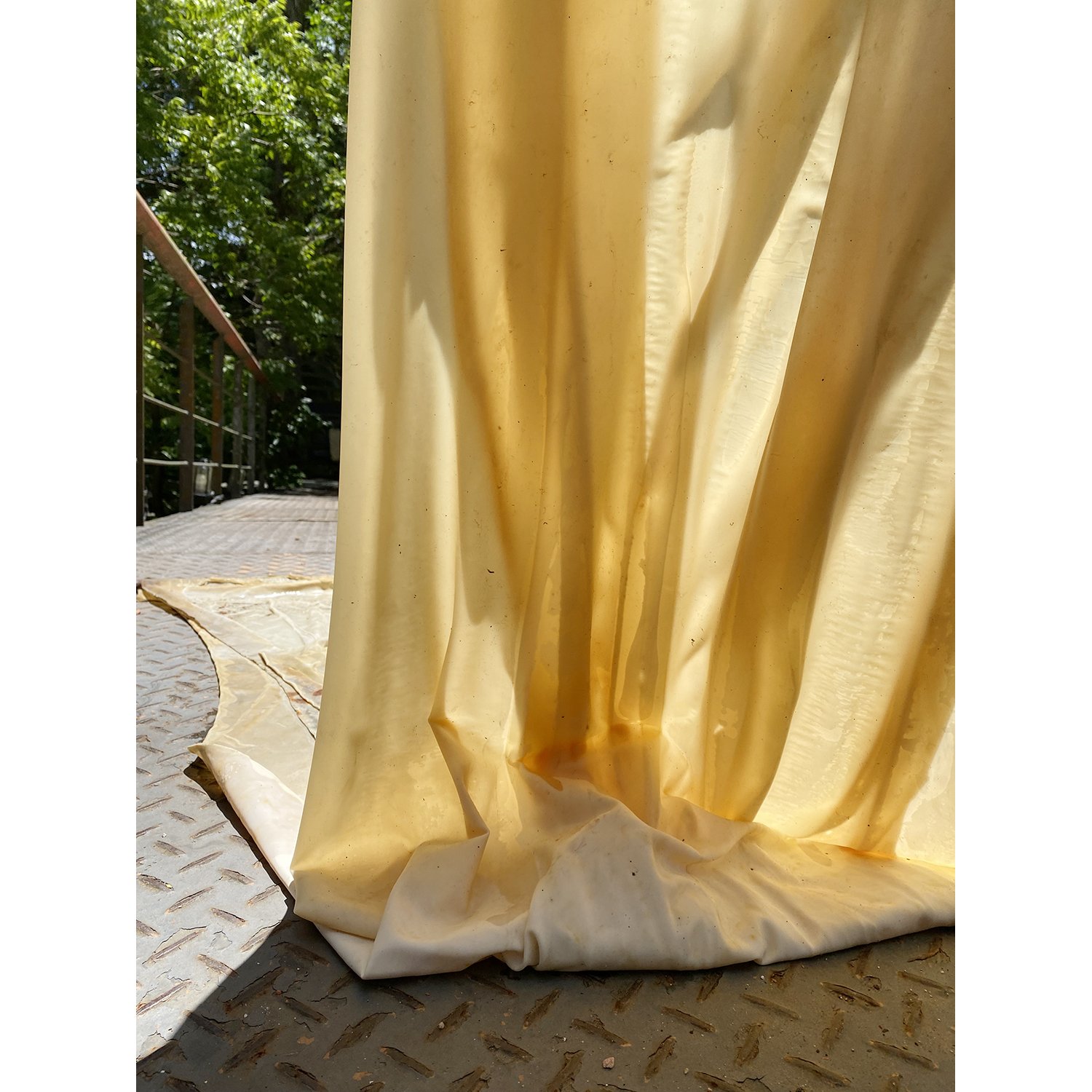
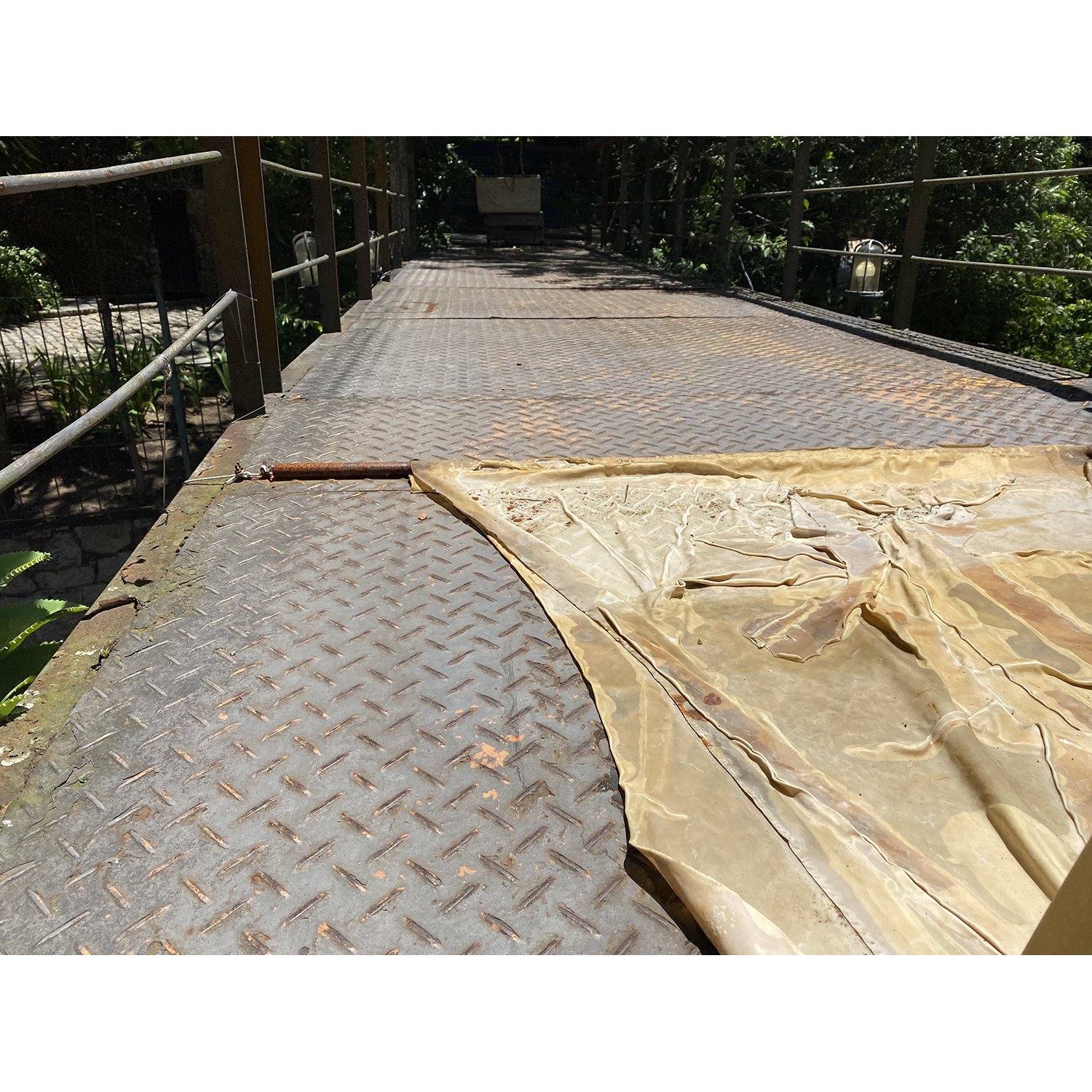
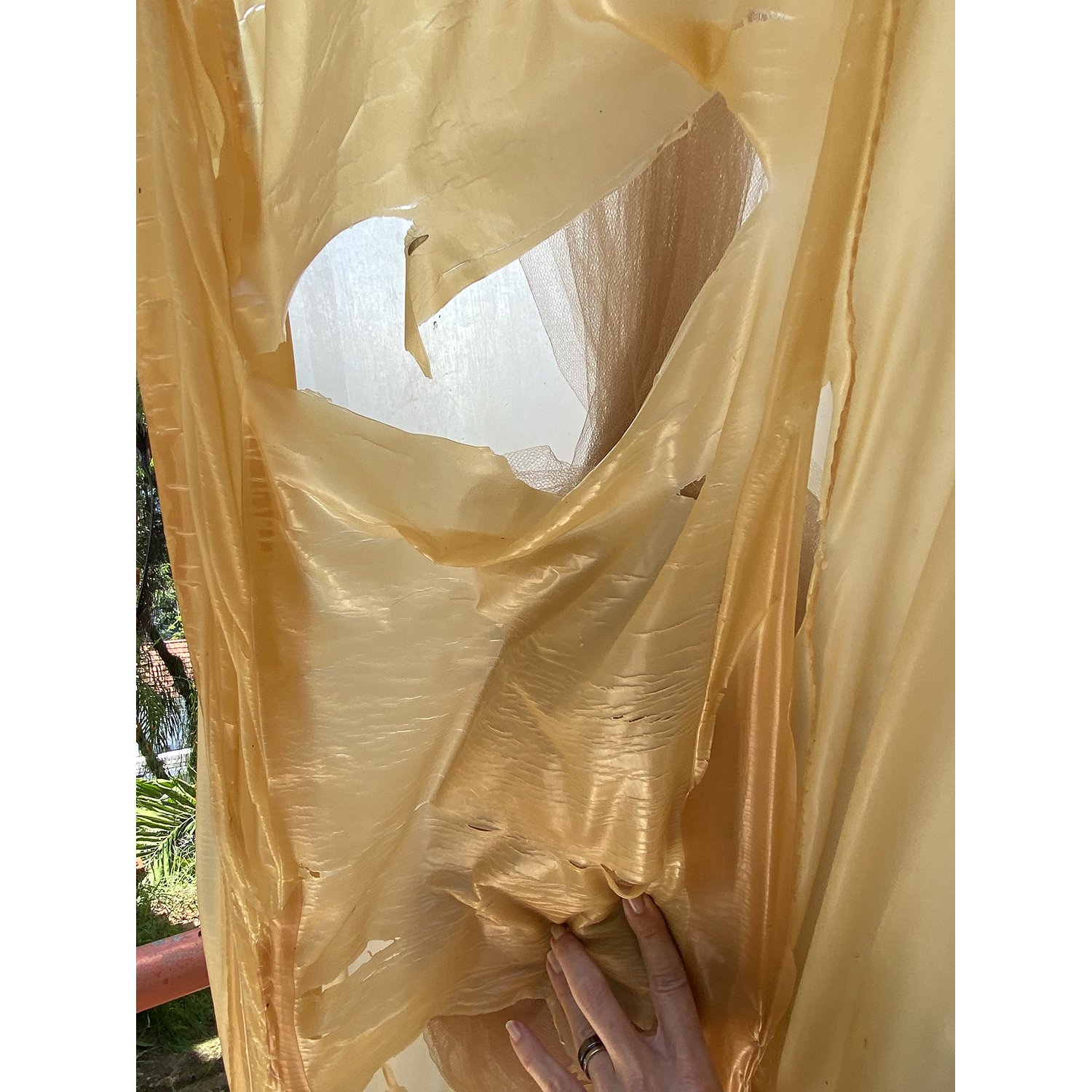
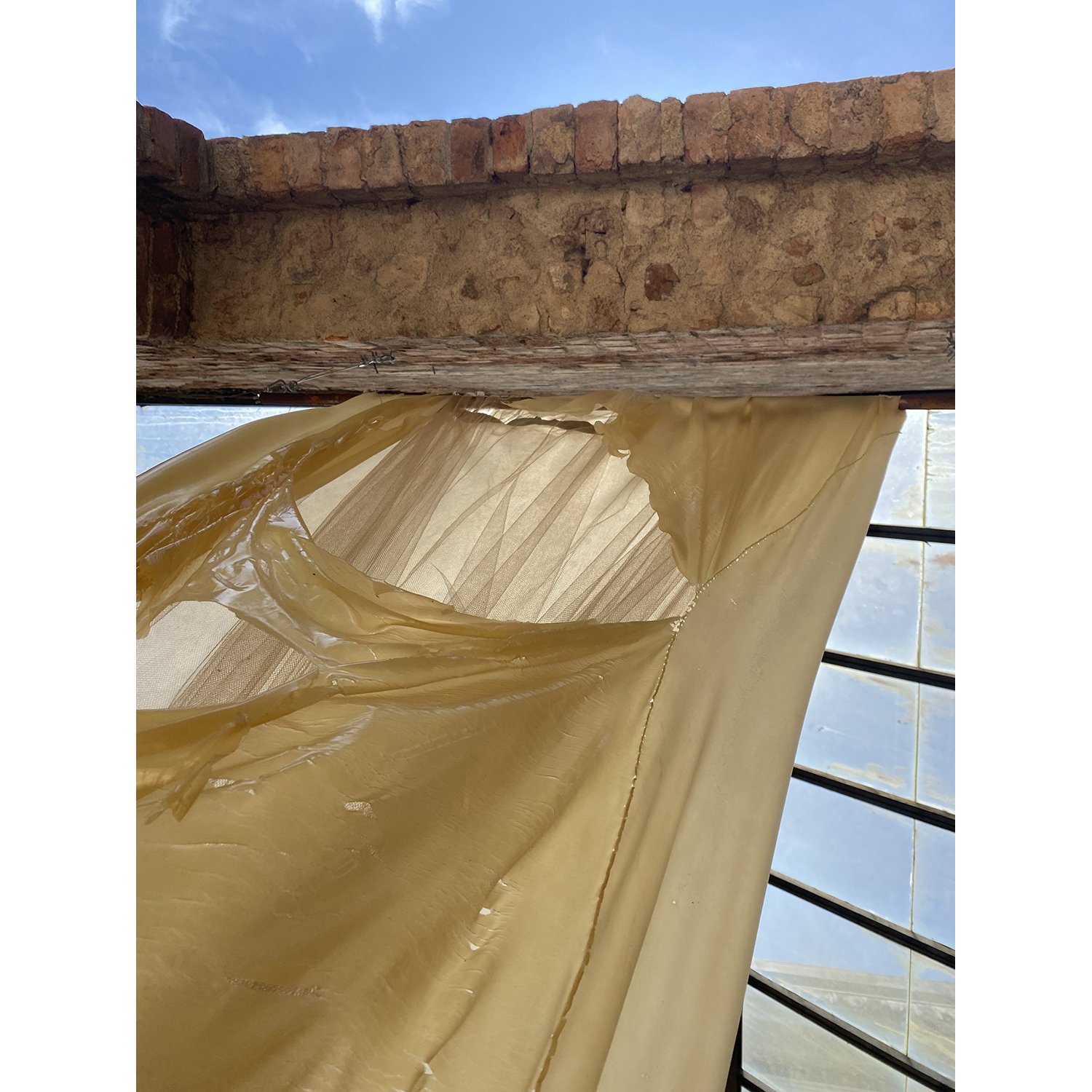

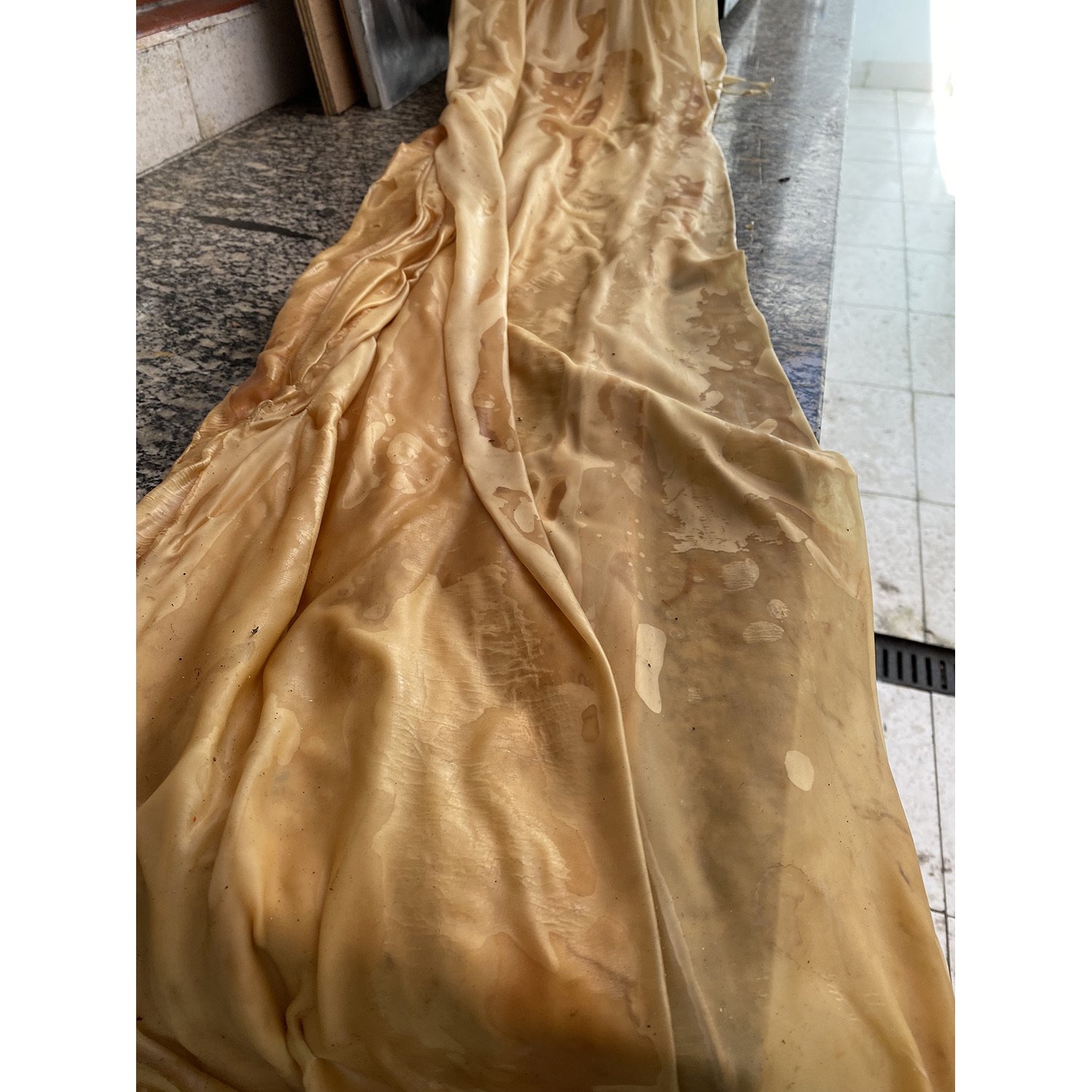
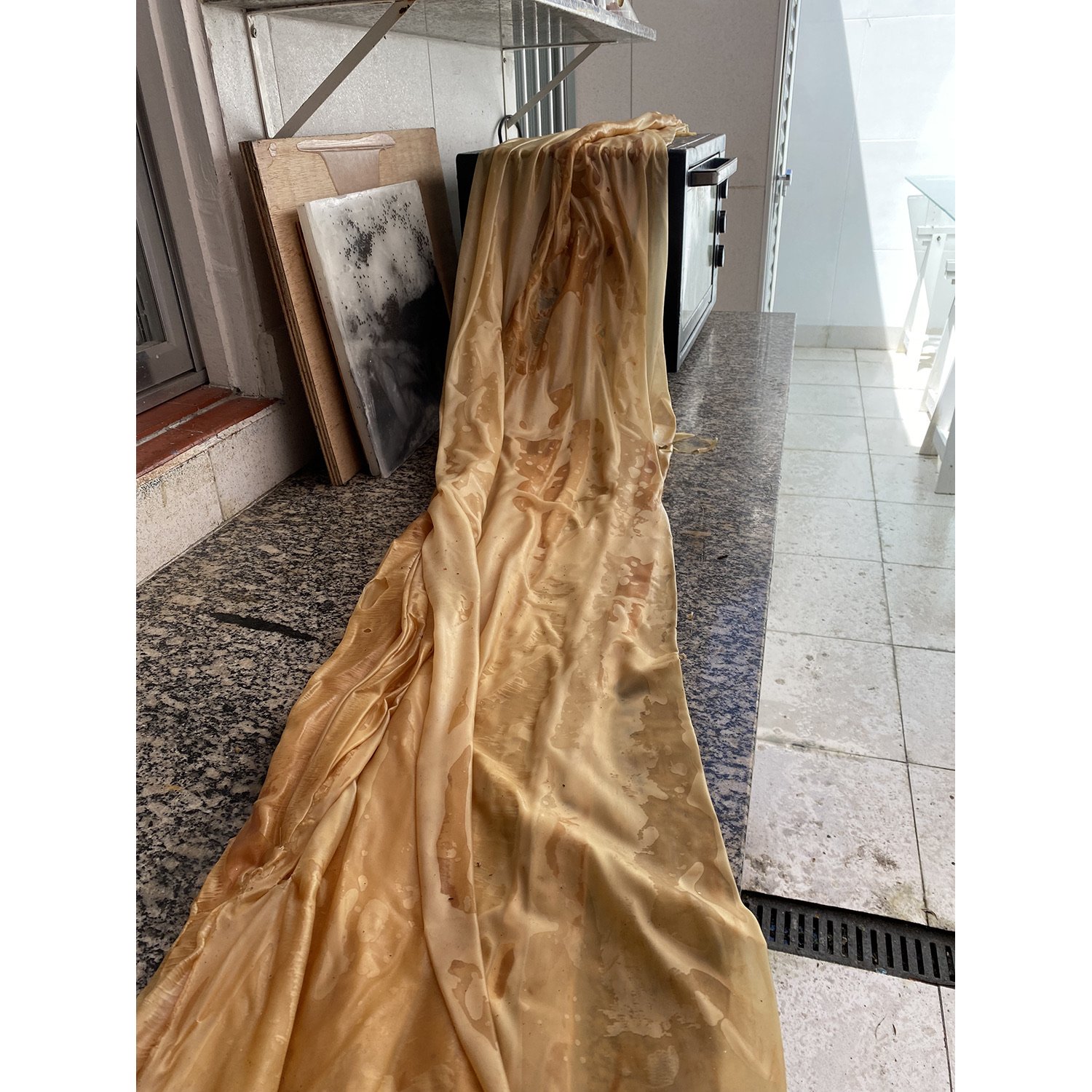

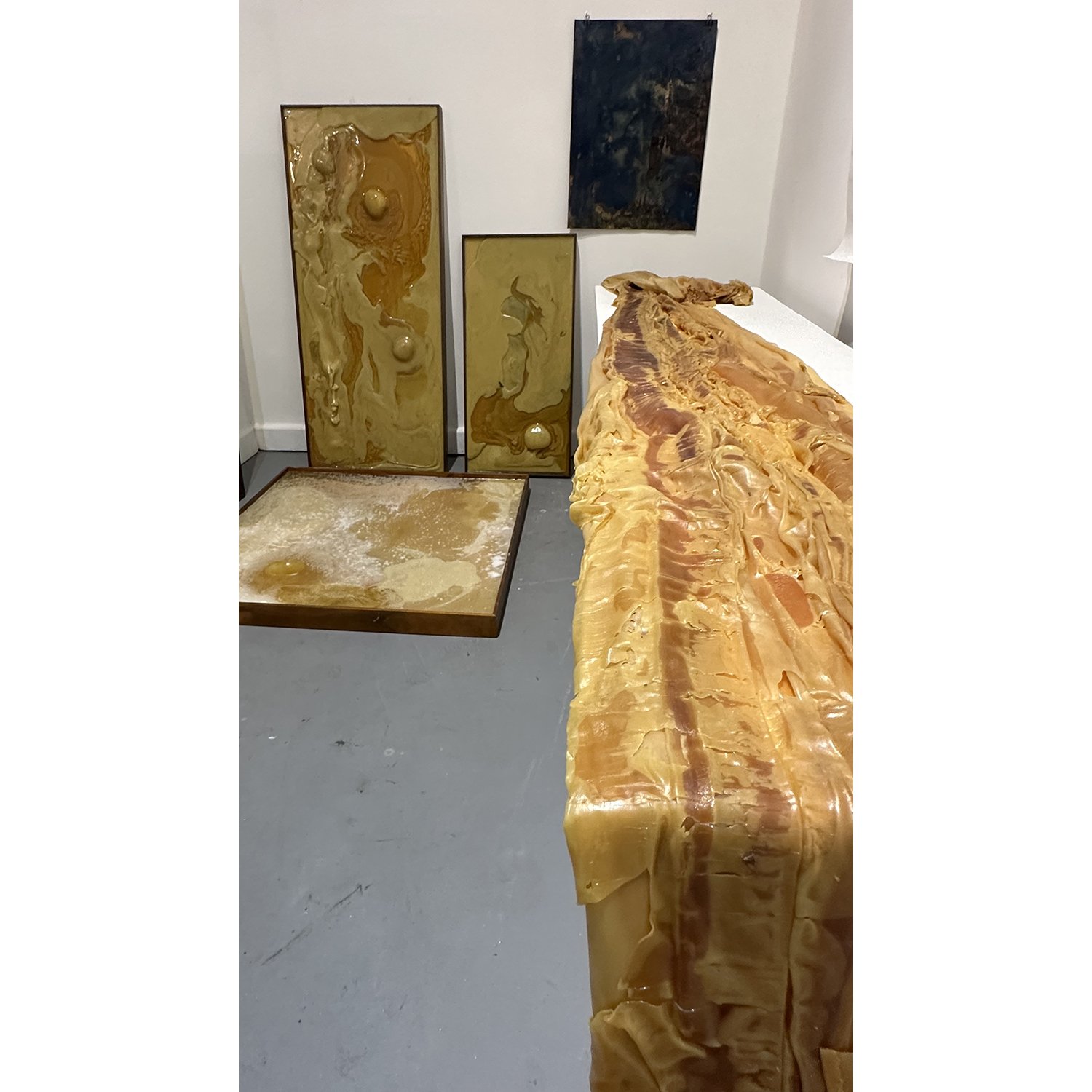
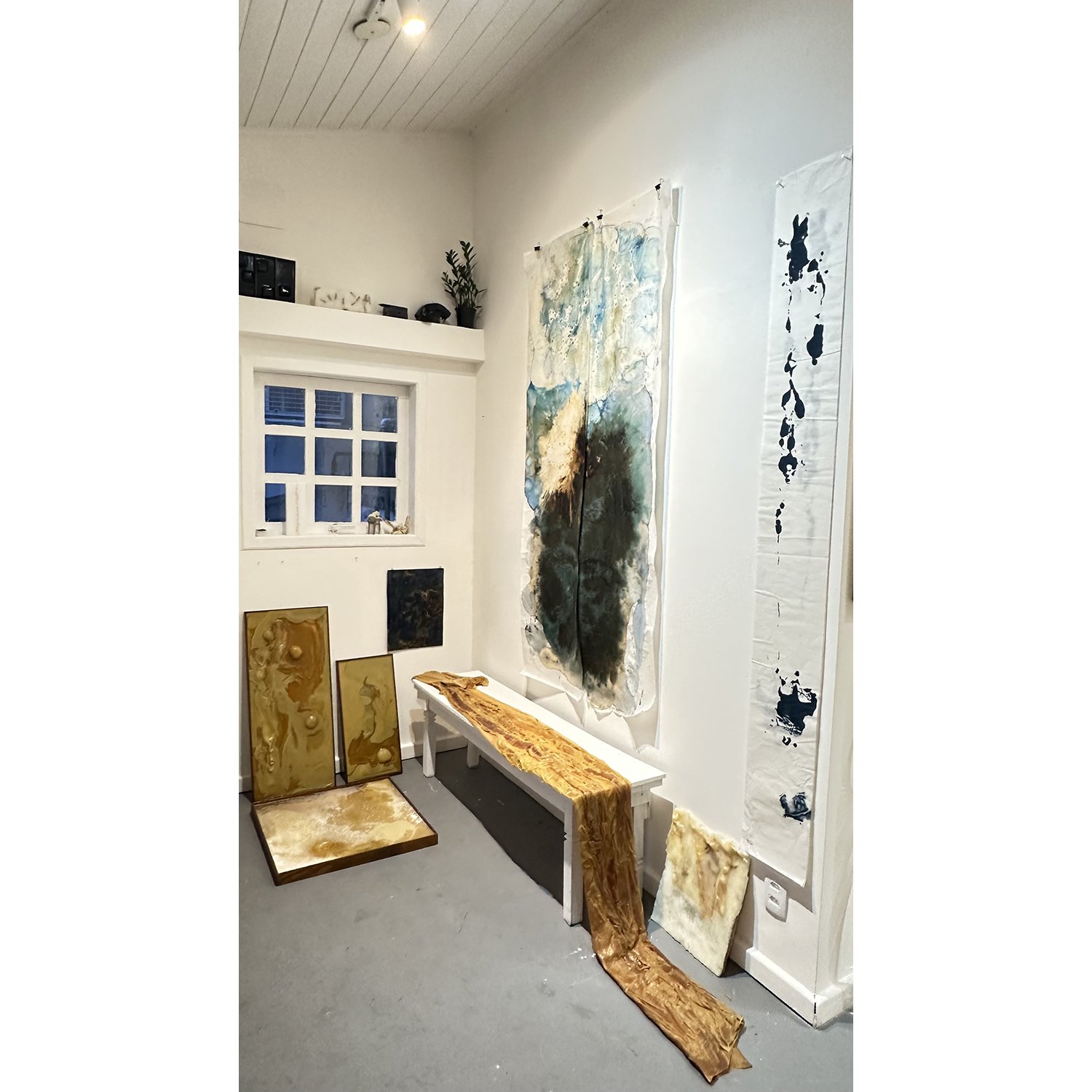
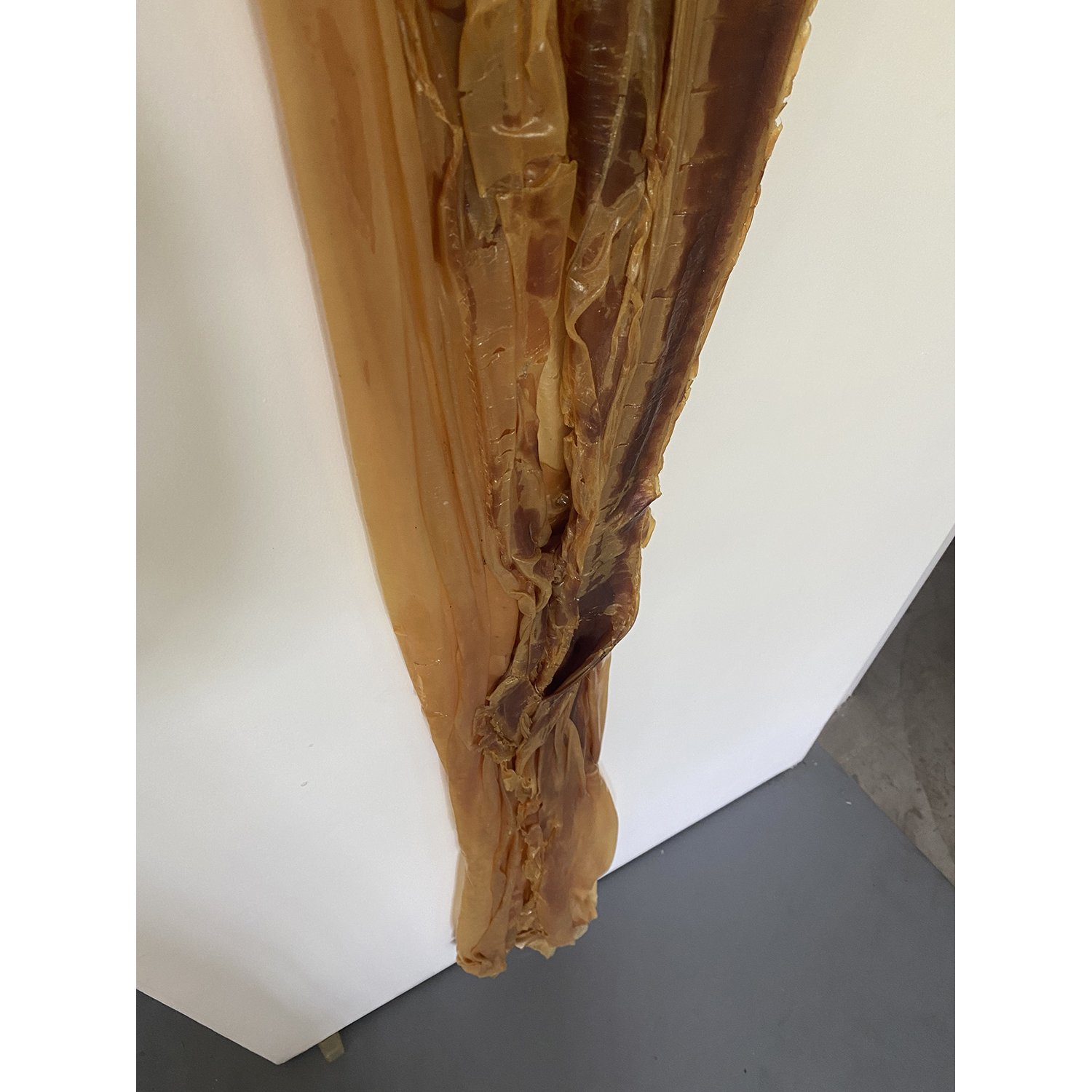
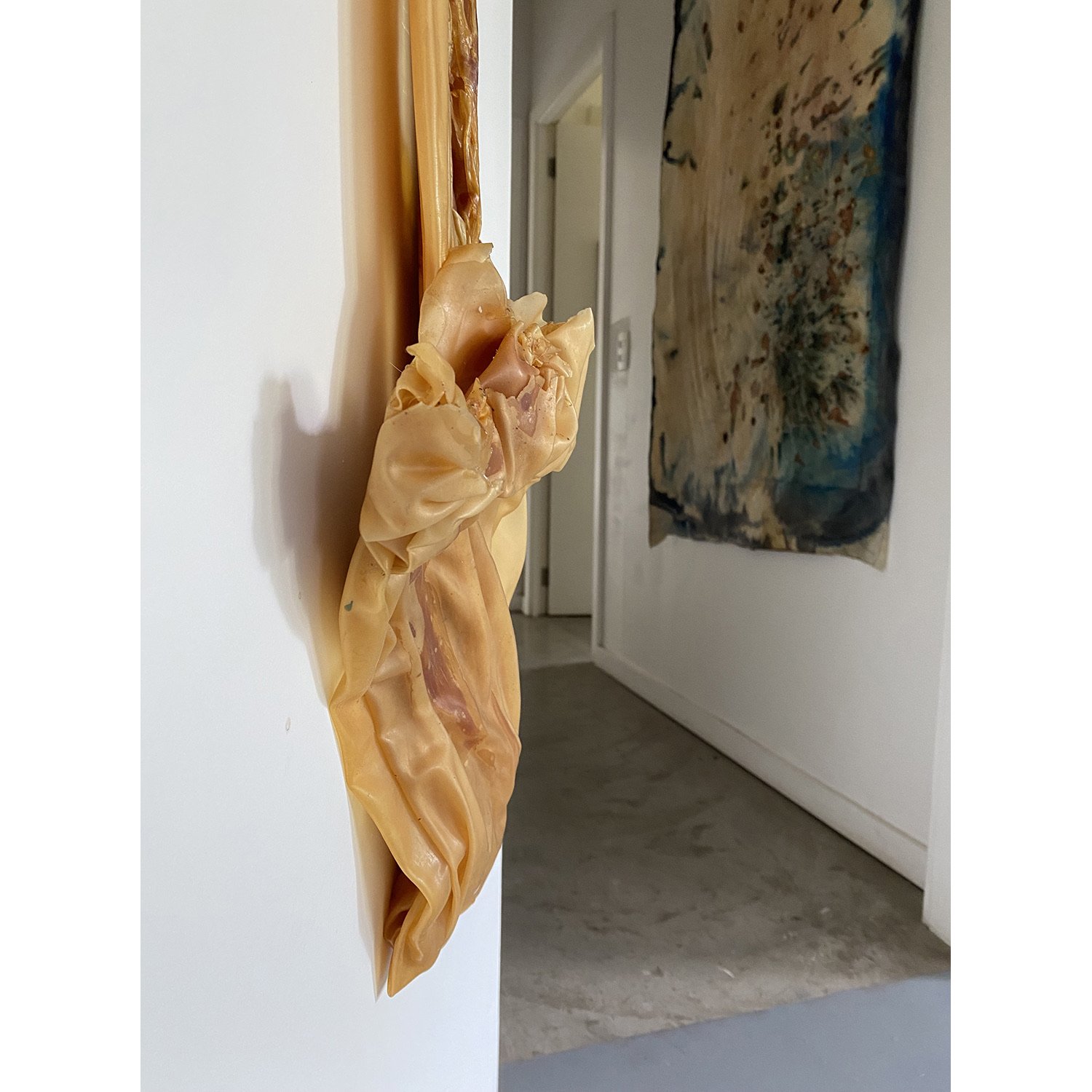
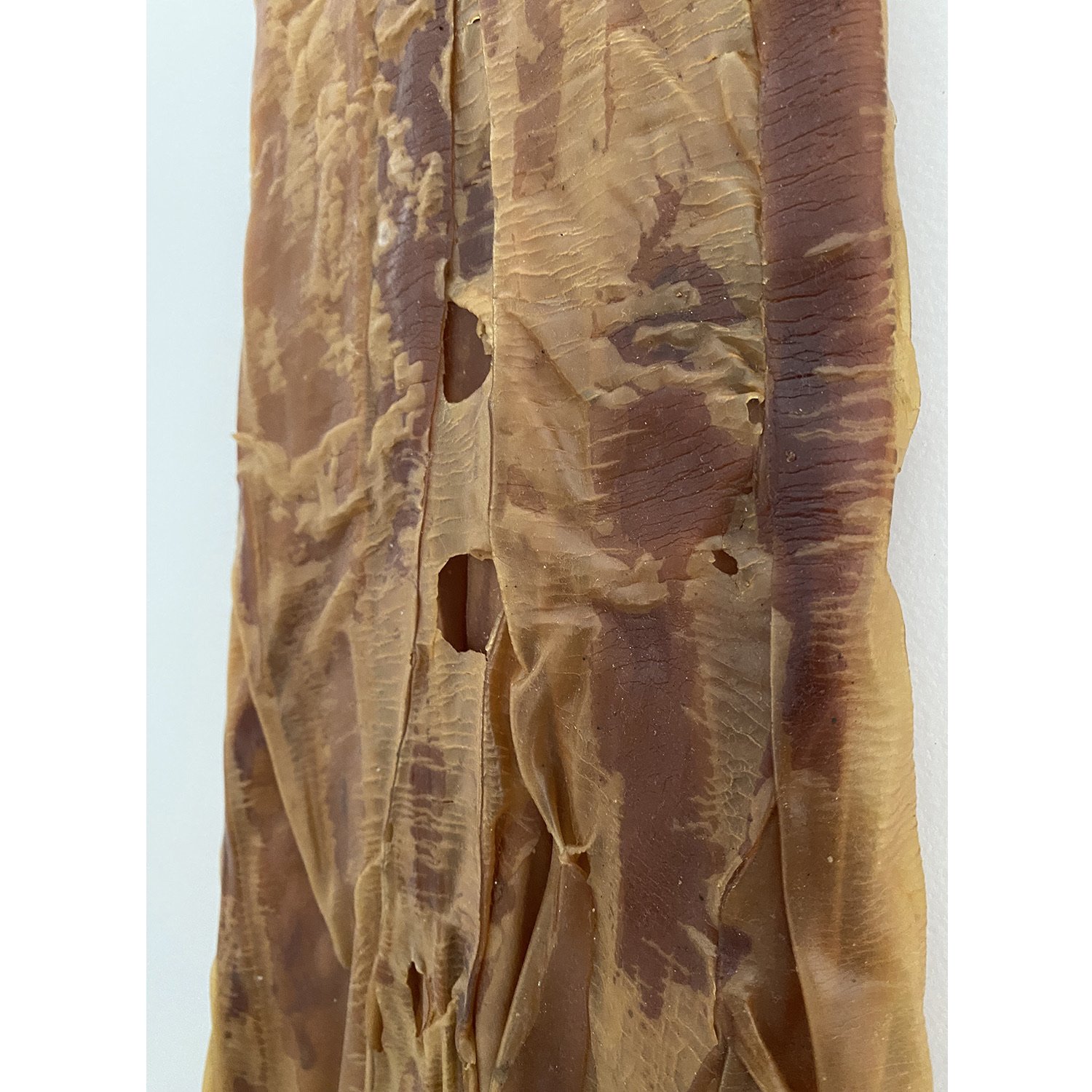
[[WITHOUT A PASSAGE TO HEAVEN///SEM PASSAGEM PARA O CÉU]] - Site Specific [[between///entre o]] Parque das Ruínas [[and///e o museu]] Chácara do Céu - Rio de Janeiro (2022)
[[Wax, latex, tulle, iron tubes, steel cables and wind///Cera, látex, tule, tubos de ferro, cabos de aço e vento]]
320x100x70cm / 126x39x27inches
[[The history of spaces is also the history of powers. By extension, it is about the confusion of the public with the private in the intimacy of power; and about the difference between promoting artistic activity as a private action or as preservation of cultural heritage. To find Palladian ruins in the midst of this motherly nature is to reflect on the patriarchal structure of colonial Brazil, where agrarian slaveholding oligarchies repeat the structures of their farmhouses in the city after “Independence”. At the end of the 19th century, despite the modern facades in imported neoclassical style, the belle-époque salons, European literature and fashions, most Brazilians - freed citizens, migrants and squatters - lived in barbaric poverty. The clientele and patronage system perpetuated elitist, anti-democratic and authoritarian values that persist to this day.
As we occupy the remains of a historic residence, we experience it as a spectacle rather than a threat. My work reinforces what I see; with it, I respond to the elements that remind me of death and decay to which I manifest a silent resistance. The loss of confidence in my ability to interfere in social and behavioral transformations, led me to seek a certain opacity in the face of the absurdity that characterizes the Brazilian reality itself in relation to the social and economic aspects. Confusing the usual codes of identification, something insinuates itself and frees us from the obvious presence of things already seen. Somehow we live like specters in this abandoned and meaningless world. The work begins and ends in an invisible zone, as a tool for internal investigation. Culturally, we are used to the argument of the “natural” connection between woman and home. I am interested in exploring the idea of a being structured by the private sphere, that ends up incorporated into domestic architecture.
Exempt from the temporal limitations of the characters going through their lives, the walls witness evolutions. In them wide porticoes and openings are torn to let the flux, soul generating light, penetrate. In this perspective, the construction of my work takes place based on the structure of the home that limits it and generates a certain erasure of female wills, wishes and desires. A smooth landscape is crafted using Artemis' skin. I think about the freedom to create other forms for life, lighter, softer and smoother. The forces that act on the soft sculpture activate its membrane with the possibility of imagining new sensibilities for itself and for the world. A way to inhabit one's own skin and escape the weight of reality.
The latex-skin is light and malleable and is constantly changing. It does not find a point of stabilization, but varied and changing points based on which it updates itself in relation to the transformations of the world. Over time it will wear out and break. Unmasking the technologies of power invested in his body. This disruption opens up possibilities for the production of difference. Another of herself, another woman in combat, who allies herself with her own movements and breaks everything that imprisons her./// A história dos espaços é também a história dos poderes. E, por extensão, sobre a confusão entre o público e o privado na intimidade do poder. Sobre a diferença entre fomentar a atividade artística como ação privada ou como preservação do patrimônio cultural. Encontrar ruínas Palladianas no seio dessa natureza mátria é refletir sobre a estrutura patriarcal do Brasil-colônia, onde oligarquias agrárias escravistas repetem as estruturas dos casarões de fazenda na urbe após a “independência”. No fim do século XIX, apesar das fachadas modernas em estilo neo-clássico importado, dos salões belle-époque, dos saraus de literatura e modas européias, a maioria dos brasileiros - cidadão libertos, migrantes e posseiros - vivia numa pobreza bárbara. Os valores elitistas, anti-democráticos e autoritários que persistem até hoje fundam-se no sistema de clientela e patronagem que nasce ali.
Ao ocuparmos os restos de uma residência histórica, vivenciamos-la como um espetáculo em vez de uma ameaça. O meu trabalho reforça o que vejo; com ele respondo aos elementos que me lembram a morte e a decadência, aos quais manifesto uma resistência silenciosa. A perda de confiança na capacidade de interferir nas transformações sociais e de comportamento, me levou à busca de certa opacidade diante do absurdo que caracteriza a própria realidade brasileira em relação ao aspecto social e econômico. Confundindo os códigos habituais de identificação, algo se insinua e nos liberta da presença óbvia das coisas já vistas. De alguma forma, vivemos como espectros nesse mundo abandonado e sem sentido. A obra nasce e termina em uma zona invisível, como constituindo uma ferramenta de investigação interna. Culturalmente estamos habituados ao argumento da ligação “natural" entre a mulher e o lar. Me interessa explorar a ideia de um ser estruturado pela esfera privada que acaba por incorporar-se à arquitetura doméstica.
Isentas às limitações temporais das personagens atravessando suas vidas, as paredes presenciam evoluções. Nelas rasgam-se largos pórticos e aberturas que deixam penetrar a flux, alma luz geradora. Nessa perspectiva, a construção da obra se dá com base na estrutura do lar que a limita e gera certo apagamento de anseios, das vontades e dos desejos femininos. Uma paisagem suave é elaborada usando a pele de Artemis. Penso na liberdade de elaborar outras formas para a vida, mais leves, macias e suaves. As forças que atuam sobre ela ativam sua membrana com a possibilidade de imaginar novas sensibilidades para si e para o mundo. Uma forma de habitar a própria pele e escapar ao peso da realidade.
A pele-látex é leve e maleável e está em mutação constante. Não encontra ponto de estabilização, mas pontos variados e cambiantes com base nos quais se atualiza na relação com as transformações do mundo. Com o tempo irá se desgastar e romper. Desmascarando as tecnologias de poder investidas em seu corpo. Este rompimento abre possibilidades para a produção da diferença. Outro de si, outra mulher em combate, que alia-se aos próprios movimentos e arrebenta tudo aquilo que a aprisiona.]]
Patricia Borges, 2022